Forecasting and Location Strategy Analysis: The Warehouse Group Report
VerifiedAdded on 2022/11/28
|8
|1858
|161
Report
AI Summary
This report provides an analysis of forecasting and location strategies for The Warehouse Group (TWG), a major New Zealand retailer. It begins by defining forecasting and its significance for business planning, emphasizing the use of statistical methods and the importance of anticipating future events and market changes. The report then examines TWG's financial performance over the past five years, including an analysis of its income statements and profit forecasts. It explores TWG's location strategy, highlighting the importance of strategic placement for attracting customers and talent. The report discusses TWG's challenges, such as competition and rising operating costs, and suggests strategies for improvement, including cost reduction and the utilization of marketing strategies. It also considers opportunities for market growth through international expansion. The report references the TWG's annual reports and industry publications to support its findings and recommendations. The report concludes by emphasizing the need for TWG to carefully plan its strategies, keeping in mind the online shopping trend and competition in the market, to ensure that customer needs are the prime issue.
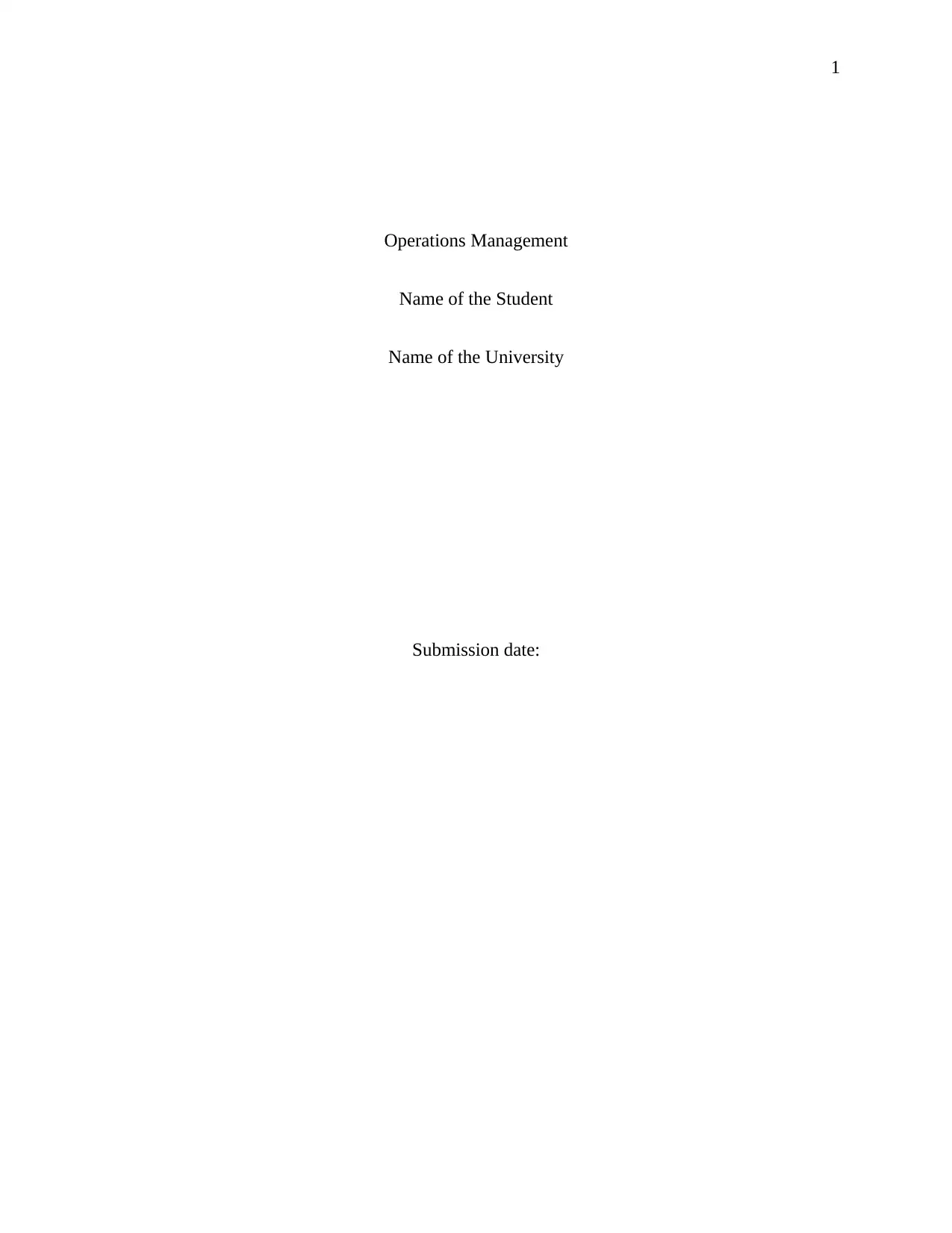
1
Operations Management
Name of the Student
Name of the University
Submission date:
Operations Management
Name of the Student
Name of the University
Submission date:
Paraphrase This Document
Need a fresh take? Get an instant paraphrase of this document with our AI Paraphraser
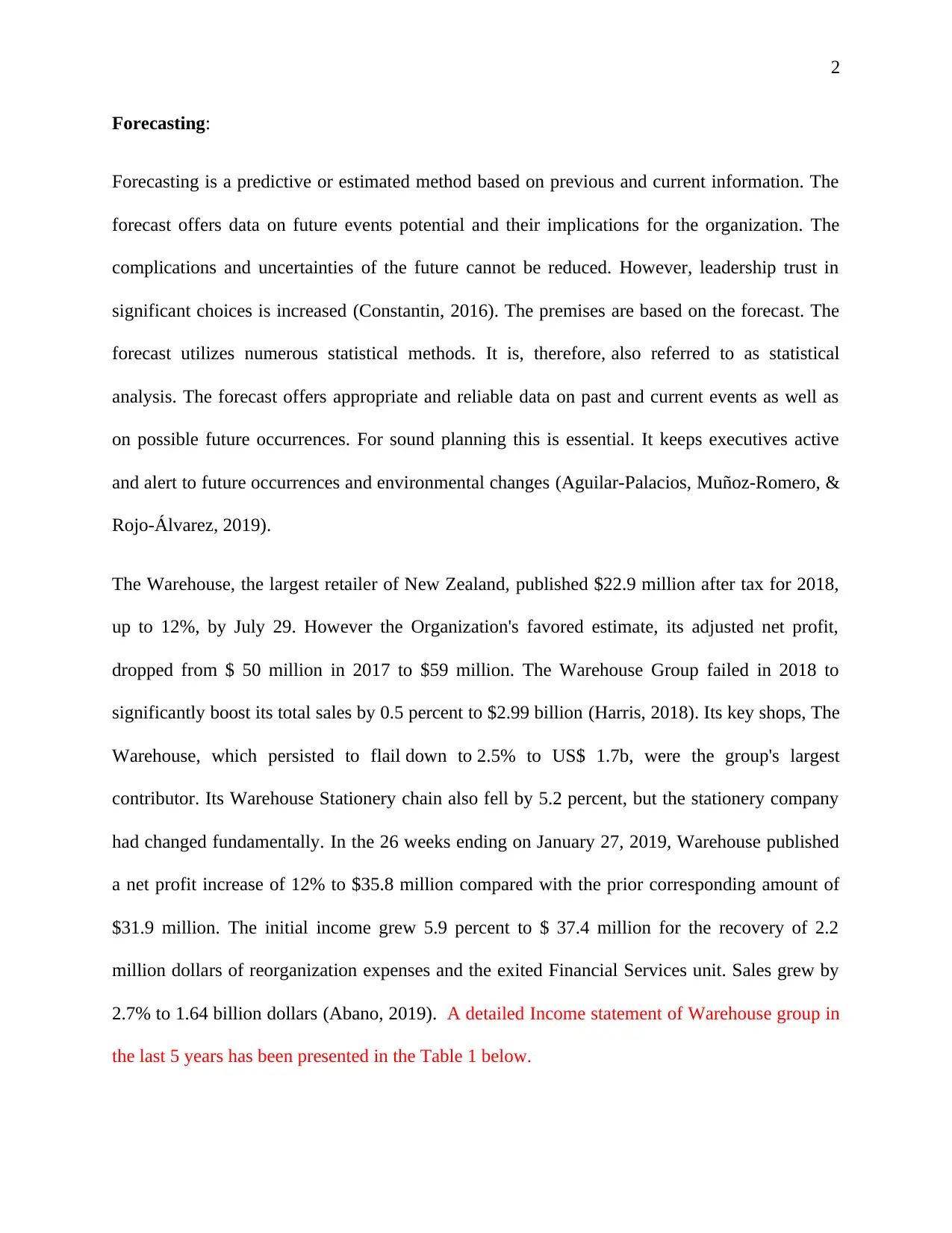
2
Forecasting:
Forecasting is a predictive or estimated method based on previous and current information. The
forecast offers data on future events potential and their implications for the organization. The
complications and uncertainties of the future cannot be reduced. However, leadership trust in
significant choices is increased (Constantin, 2016). The premises are based on the forecast. The
forecast utilizes numerous statistical methods. It is, therefore, also referred to as statistical
analysis. The forecast offers appropriate and reliable data on past and current events as well as
on possible future occurrences. For sound planning this is essential. It keeps executives active
and alert to future occurrences and environmental changes (Aguilar-Palacios, Muñoz-Romero, &
Rojo-Álvarez, 2019).
The Warehouse, the largest retailer of New Zealand, published $22.9 million after tax for 2018,
up to 12%, by July 29. However the Organization's favored estimate, its adjusted net profit,
dropped from $ 50 million in 2017 to $59 million. The Warehouse Group failed in 2018 to
significantly boost its total sales by 0.5 percent to $2.99 billion (Harris, 2018). Its key shops, The
Warehouse, which persisted to flail down to 2.5% to US$ 1.7b, were the group's largest
contributor. Its Warehouse Stationery chain also fell by 5.2 percent, but the stationery company
had changed fundamentally. In the 26 weeks ending on January 27, 2019, Warehouse published
a net profit increase of 12% to $35.8 million compared with the prior corresponding amount of
$31.9 million. The initial income grew 5.9 percent to $ 37.4 million for the recovery of 2.2
million dollars of reorganization expenses and the exited Financial Services unit. Sales grew by
2.7% to 1.64 billion dollars (Abano, 2019). A detailed Income statement of Warehouse group in
the last 5 years has been presented in the Table 1 below.
Forecasting:
Forecasting is a predictive or estimated method based on previous and current information. The
forecast offers data on future events potential and their implications for the organization. The
complications and uncertainties of the future cannot be reduced. However, leadership trust in
significant choices is increased (Constantin, 2016). The premises are based on the forecast. The
forecast utilizes numerous statistical methods. It is, therefore, also referred to as statistical
analysis. The forecast offers appropriate and reliable data on past and current events as well as
on possible future occurrences. For sound planning this is essential. It keeps executives active
and alert to future occurrences and environmental changes (Aguilar-Palacios, Muñoz-Romero, &
Rojo-Álvarez, 2019).
The Warehouse, the largest retailer of New Zealand, published $22.9 million after tax for 2018,
up to 12%, by July 29. However the Organization's favored estimate, its adjusted net profit,
dropped from $ 50 million in 2017 to $59 million. The Warehouse Group failed in 2018 to
significantly boost its total sales by 0.5 percent to $2.99 billion (Harris, 2018). Its key shops, The
Warehouse, which persisted to flail down to 2.5% to US$ 1.7b, were the group's largest
contributor. Its Warehouse Stationery chain also fell by 5.2 percent, but the stationery company
had changed fundamentally. In the 26 weeks ending on January 27, 2019, Warehouse published
a net profit increase of 12% to $35.8 million compared with the prior corresponding amount of
$31.9 million. The initial income grew 5.9 percent to $ 37.4 million for the recovery of 2.2
million dollars of reorganization expenses and the exited Financial Services unit. Sales grew by
2.7% to 1.64 billion dollars (Abano, 2019). A detailed Income statement of Warehouse group in
the last 5 years has been presented in the Table 1 below.
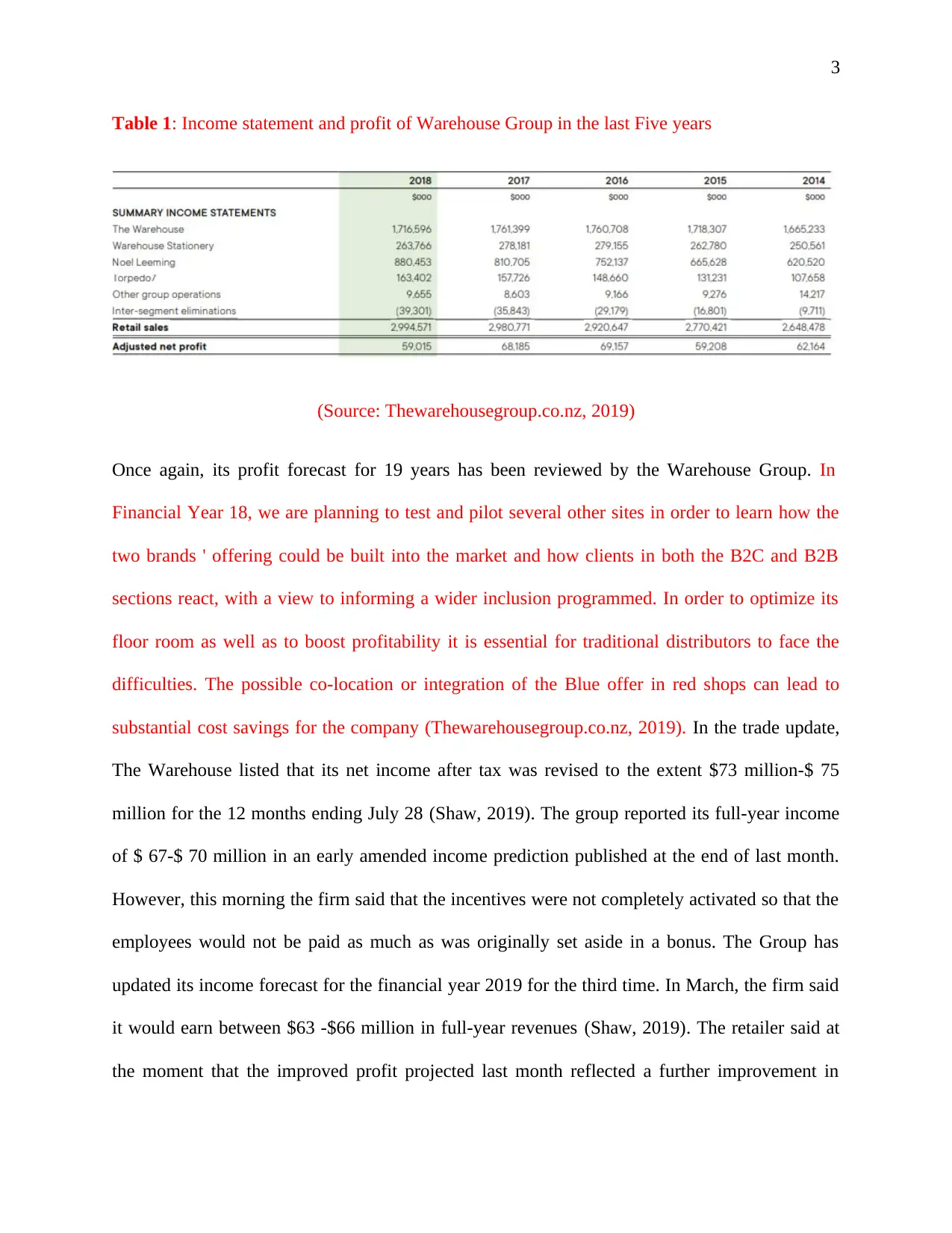
3
Table 1: Income statement and profit of Warehouse Group in the last Five years
(Source: Thewarehousegroup.co.nz, 2019)
Once again, its profit forecast for 19 years has been reviewed by the Warehouse Group. In
Financial Year 18, we are planning to test and pilot several other sites in order to learn how the
two brands ' offering could be built into the market and how clients in both the B2C and B2B
sections react, with a view to informing a wider inclusion programmed. In order to optimize its
floor room as well as to boost profitability it is essential for traditional distributors to face the
difficulties. The possible co-location or integration of the Blue offer in red shops can lead to
substantial cost savings for the company (Thewarehousegroup.co.nz, 2019). In the trade update,
The Warehouse listed that its net income after tax was revised to the extent $73 million-$ 75
million for the 12 months ending July 28 (Shaw, 2019). The group reported its full-year income
of $ 67-$ 70 million in an early amended income prediction published at the end of last month.
However, this morning the firm said that the incentives were not completely activated so that the
employees would not be paid as much as was originally set aside in a bonus. The Group has
updated its income forecast for the financial year 2019 for the third time. In March, the firm said
it would earn between $63 -$66 million in full-year revenues (Shaw, 2019). The retailer said at
the moment that the improved profit projected last month reflected a further improvement in
Table 1: Income statement and profit of Warehouse Group in the last Five years
(Source: Thewarehousegroup.co.nz, 2019)
Once again, its profit forecast for 19 years has been reviewed by the Warehouse Group. In
Financial Year 18, we are planning to test and pilot several other sites in order to learn how the
two brands ' offering could be built into the market and how clients in both the B2C and B2B
sections react, with a view to informing a wider inclusion programmed. In order to optimize its
floor room as well as to boost profitability it is essential for traditional distributors to face the
difficulties. The possible co-location or integration of the Blue offer in red shops can lead to
substantial cost savings for the company (Thewarehousegroup.co.nz, 2019). In the trade update,
The Warehouse listed that its net income after tax was revised to the extent $73 million-$ 75
million for the 12 months ending July 28 (Shaw, 2019). The group reported its full-year income
of $ 67-$ 70 million in an early amended income prediction published at the end of last month.
However, this morning the firm said that the incentives were not completely activated so that the
employees would not be paid as much as was originally set aside in a bonus. The Group has
updated its income forecast for the financial year 2019 for the third time. In March, the firm said
it would earn between $63 -$66 million in full-year revenues (Shaw, 2019). The retailer said at
the moment that the improved profit projected last month reflected a further improvement in
⊘ This is a preview!⊘
Do you want full access?
Subscribe today to unlock all pages.

Trusted by 1+ million students worldwide
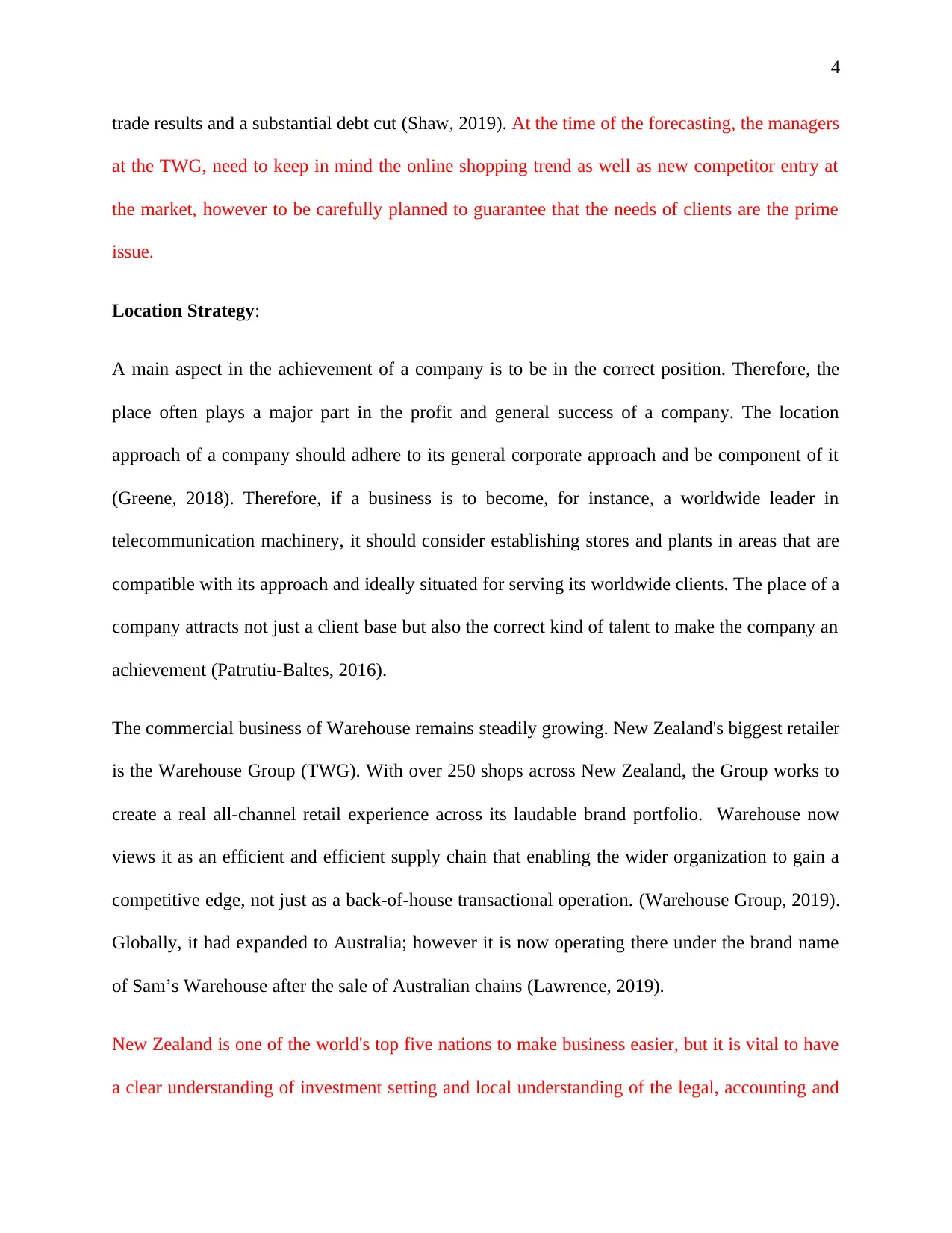
4
trade results and a substantial debt cut (Shaw, 2019). At the time of the forecasting, the managers
at the TWG, need to keep in mind the online shopping trend as well as new competitor entry at
the market, however to be carefully planned to guarantee that the needs of clients are the prime
issue.
Location Strategy:
A main aspect in the achievement of a company is to be in the correct position. Therefore, the
place often plays a major part in the profit and general success of a company. The location
approach of a company should adhere to its general corporate approach and be component of it
(Greene, 2018). Therefore, if a business is to become, for instance, a worldwide leader in
telecommunication machinery, it should consider establishing stores and plants in areas that are
compatible with its approach and ideally situated for serving its worldwide clients. The place of a
company attracts not just a client base but also the correct kind of talent to make the company an
achievement (Patrutiu-Baltes, 2016).
The commercial business of Warehouse remains steadily growing. New Zealand's biggest retailer
is the Warehouse Group (TWG). With over 250 shops across New Zealand, the Group works to
create a real all-channel retail experience across its laudable brand portfolio. Warehouse now
views it as an efficient and efficient supply chain that enabling the wider organization to gain a
competitive edge, not just as a back-of-house transactional operation. (Warehouse Group, 2019).
Globally, it had expanded to Australia; however it is now operating there under the brand name
of Sam’s Warehouse after the sale of Australian chains (Lawrence, 2019).
New Zealand is one of the world's top five nations to make business easier, but it is vital to have
a clear understanding of investment setting and local understanding of the legal, accounting and
trade results and a substantial debt cut (Shaw, 2019). At the time of the forecasting, the managers
at the TWG, need to keep in mind the online shopping trend as well as new competitor entry at
the market, however to be carefully planned to guarantee that the needs of clients are the prime
issue.
Location Strategy:
A main aspect in the achievement of a company is to be in the correct position. Therefore, the
place often plays a major part in the profit and general success of a company. The location
approach of a company should adhere to its general corporate approach and be component of it
(Greene, 2018). Therefore, if a business is to become, for instance, a worldwide leader in
telecommunication machinery, it should consider establishing stores and plants in areas that are
compatible with its approach and ideally situated for serving its worldwide clients. The place of a
company attracts not just a client base but also the correct kind of talent to make the company an
achievement (Patrutiu-Baltes, 2016).
The commercial business of Warehouse remains steadily growing. New Zealand's biggest retailer
is the Warehouse Group (TWG). With over 250 shops across New Zealand, the Group works to
create a real all-channel retail experience across its laudable brand portfolio. Warehouse now
views it as an efficient and efficient supply chain that enabling the wider organization to gain a
competitive edge, not just as a back-of-house transactional operation. (Warehouse Group, 2019).
Globally, it had expanded to Australia; however it is now operating there under the brand name
of Sam’s Warehouse after the sale of Australian chains (Lawrence, 2019).
New Zealand is one of the world's top five nations to make business easier, but it is vital to have
a clear understanding of investment setting and local understanding of the legal, accounting and
Paraphrase This Document
Need a fresh take? Get an instant paraphrase of this document with our AI Paraphraser
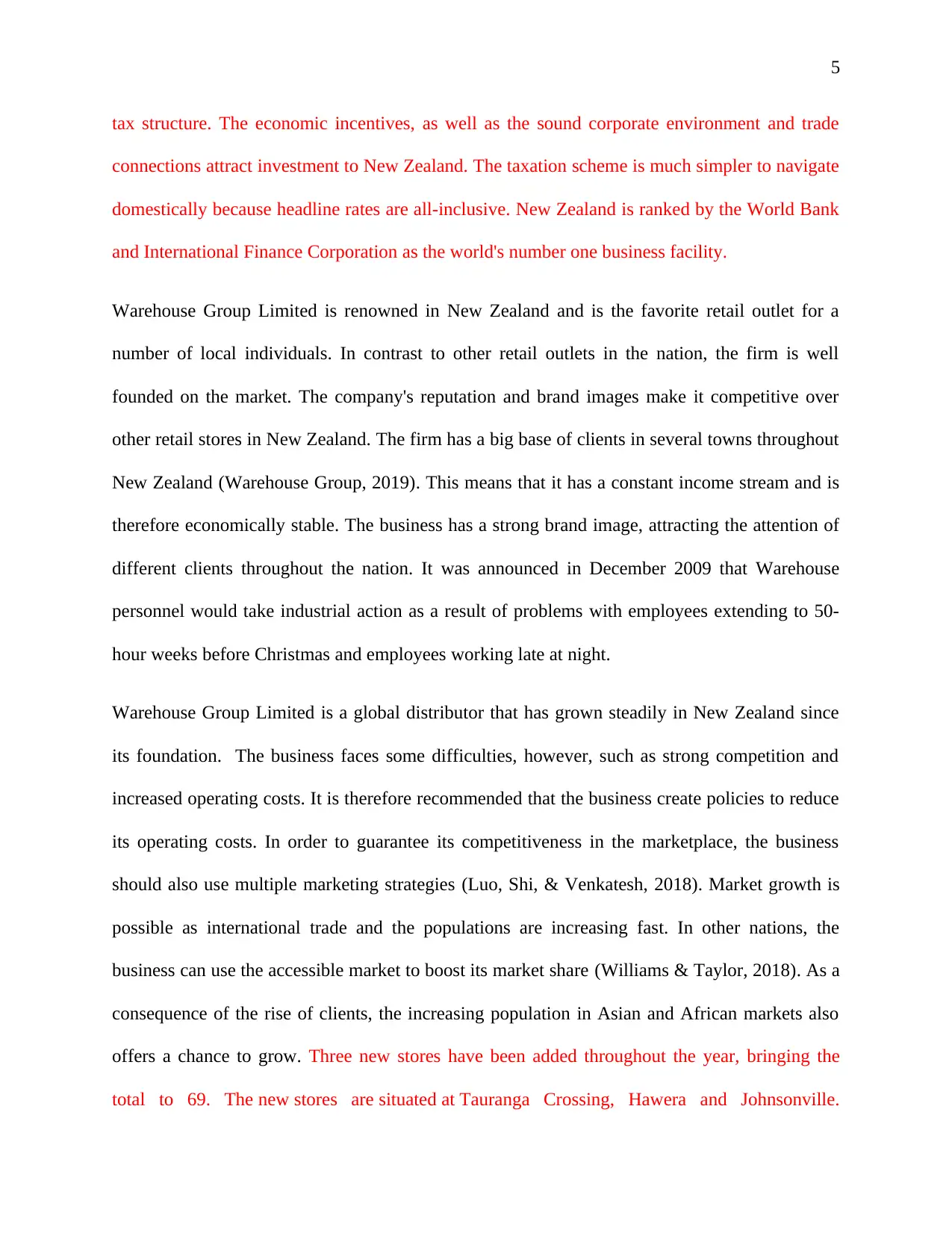
5
tax structure. The economic incentives, as well as the sound corporate environment and trade
connections attract investment to New Zealand. The taxation scheme is much simpler to navigate
domestically because headline rates are all-inclusive. New Zealand is ranked by the World Bank
and International Finance Corporation as the world's number one business facility.
Warehouse Group Limited is renowned in New Zealand and is the favorite retail outlet for a
number of local individuals. In contrast to other retail outlets in the nation, the firm is well
founded on the market. The company's reputation and brand images make it competitive over
other retail stores in New Zealand. The firm has a big base of clients in several towns throughout
New Zealand (Warehouse Group, 2019). This means that it has a constant income stream and is
therefore economically stable. The business has a strong brand image, attracting the attention of
different clients throughout the nation. It was announced in December 2009 that Warehouse
personnel would take industrial action as a result of problems with employees extending to 50-
hour weeks before Christmas and employees working late at night.
Warehouse Group Limited is a global distributor that has grown steadily in New Zealand since
its foundation. The business faces some difficulties, however, such as strong competition and
increased operating costs. It is therefore recommended that the business create policies to reduce
its operating costs. In order to guarantee its competitiveness in the marketplace, the business
should also use multiple marketing strategies (Luo, Shi, & Venkatesh, 2018). Market growth is
possible as international trade and the populations are increasing fast. In other nations, the
business can use the accessible market to boost its market share (Williams & Taylor, 2018). As a
consequence of the rise of clients, the increasing population in Asian and African markets also
offers a chance to grow. Three new stores have been added throughout the year, bringing the
total to 69. The new stores are situated at Tauranga Crossing, Hawera and Johnsonville.
tax structure. The economic incentives, as well as the sound corporate environment and trade
connections attract investment to New Zealand. The taxation scheme is much simpler to navigate
domestically because headline rates are all-inclusive. New Zealand is ranked by the World Bank
and International Finance Corporation as the world's number one business facility.
Warehouse Group Limited is renowned in New Zealand and is the favorite retail outlet for a
number of local individuals. In contrast to other retail outlets in the nation, the firm is well
founded on the market. The company's reputation and brand images make it competitive over
other retail stores in New Zealand. The firm has a big base of clients in several towns throughout
New Zealand (Warehouse Group, 2019). This means that it has a constant income stream and is
therefore economically stable. The business has a strong brand image, attracting the attention of
different clients throughout the nation. It was announced in December 2009 that Warehouse
personnel would take industrial action as a result of problems with employees extending to 50-
hour weeks before Christmas and employees working late at night.
Warehouse Group Limited is a global distributor that has grown steadily in New Zealand since
its foundation. The business faces some difficulties, however, such as strong competition and
increased operating costs. It is therefore recommended that the business create policies to reduce
its operating costs. In order to guarantee its competitiveness in the marketplace, the business
should also use multiple marketing strategies (Luo, Shi, & Venkatesh, 2018). Market growth is
possible as international trade and the populations are increasing fast. In other nations, the
business can use the accessible market to boost its market share (Williams & Taylor, 2018). As a
consequence of the rise of clients, the increasing population in Asian and African markets also
offers a chance to grow. Three new stores have been added throughout the year, bringing the
total to 69. The new stores are situated at Tauranga Crossing, Hawera and Johnsonville.
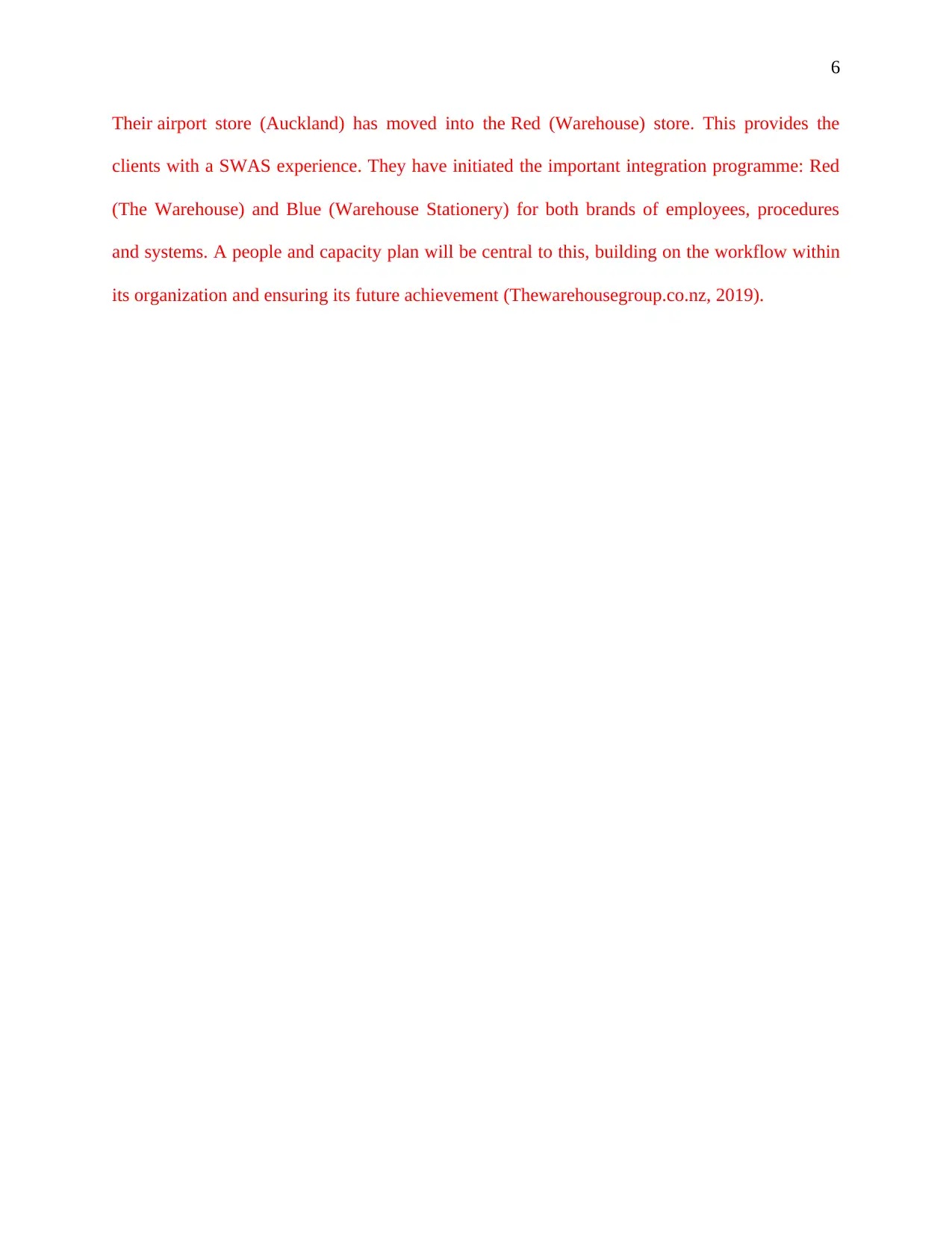
6
Their airport store (Auckland) has moved into the Red (Warehouse) store. This provides the
clients with a SWAS experience. They have initiated the important integration programme: Red
(The Warehouse) and Blue (Warehouse Stationery) for both brands of employees, procedures
and systems. A people and capacity plan will be central to this, building on the workflow within
its organization and ensuring its future achievement (Thewarehousegroup.co.nz, 2019).
Their airport store (Auckland) has moved into the Red (Warehouse) store. This provides the
clients with a SWAS experience. They have initiated the important integration programme: Red
(The Warehouse) and Blue (Warehouse Stationery) for both brands of employees, procedures
and systems. A people and capacity plan will be central to this, building on the workflow within
its organization and ensuring its future achievement (Thewarehousegroup.co.nz, 2019).
⊘ This is a preview!⊘
Do you want full access?
Subscribe today to unlock all pages.

Trusted by 1+ million students worldwide
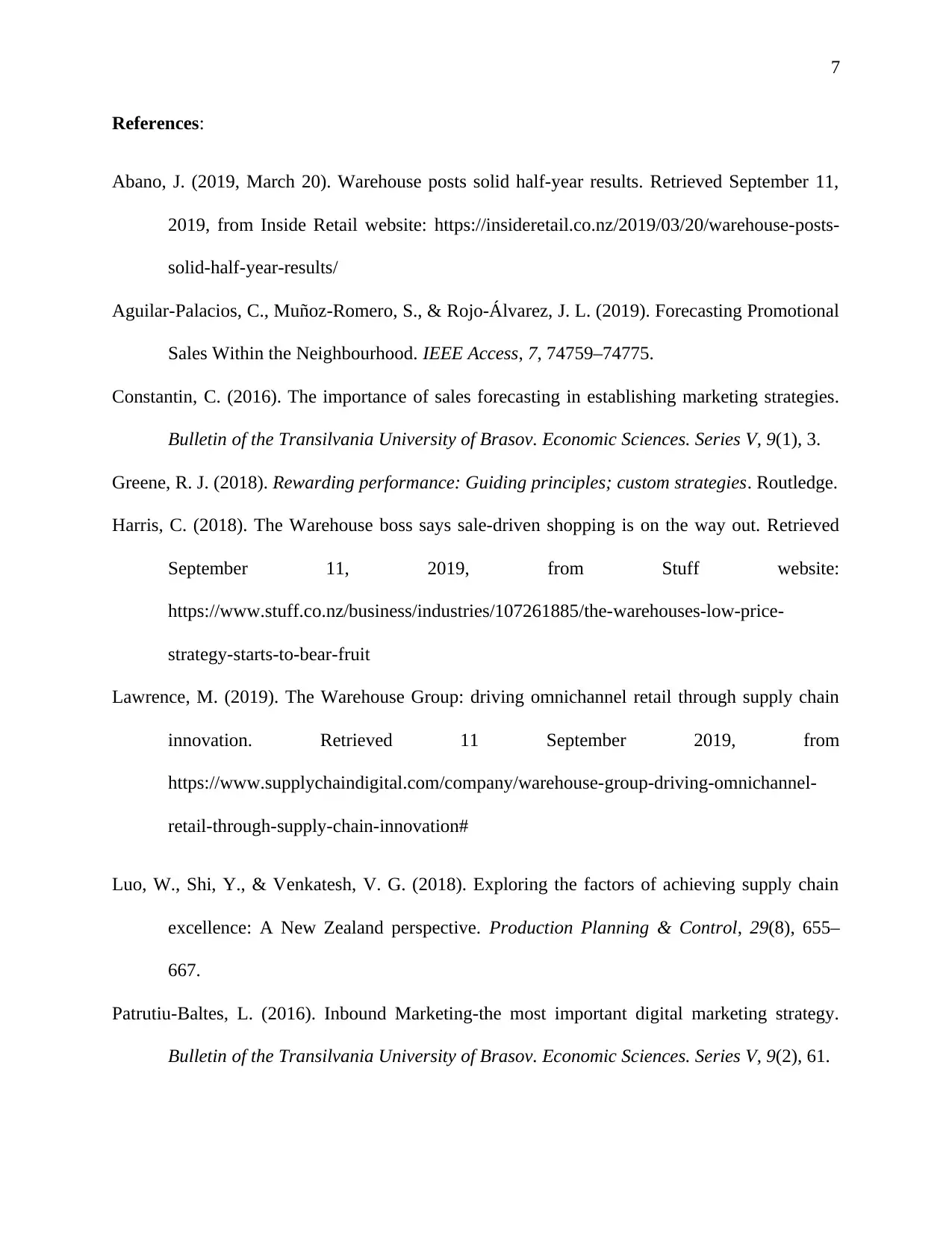
7
References:
Abano, J. (2019, March 20). Warehouse posts solid half-year results. Retrieved September 11,
2019, from Inside Retail website: https://insideretail.co.nz/2019/03/20/warehouse-posts-
solid-half-year-results/
Aguilar-Palacios, C., Muñoz-Romero, S., & Rojo-Álvarez, J. L. (2019). Forecasting Promotional
Sales Within the Neighbourhood. IEEE Access, 7, 74759–74775.
Constantin, C. (2016). The importance of sales forecasting in establishing marketing strategies.
Bulletin of the Transilvania University of Brasov. Economic Sciences. Series V, 9(1), 3.
Greene, R. J. (2018). Rewarding performance: Guiding principles; custom strategies. Routledge.
Harris, C. (2018). The Warehouse boss says sale-driven shopping is on the way out. Retrieved
September 11, 2019, from Stuff website:
https://www.stuff.co.nz/business/industries/107261885/the-warehouses-low-price-
strategy-starts-to-bear-fruit
Lawrence, M. (2019). The Warehouse Group: driving omnichannel retail through supply chain
innovation. Retrieved 11 September 2019, from
https://www.supplychaindigital.com/company/warehouse-group-driving-omnichannel-
retail-through-supply-chain-innovation#
Luo, W., Shi, Y., & Venkatesh, V. G. (2018). Exploring the factors of achieving supply chain
excellence: A New Zealand perspective. Production Planning & Control, 29(8), 655–
667.
Patrutiu-Baltes, L. (2016). Inbound Marketing-the most important digital marketing strategy.
Bulletin of the Transilvania University of Brasov. Economic Sciences. Series V, 9(2), 61.
References:
Abano, J. (2019, March 20). Warehouse posts solid half-year results. Retrieved September 11,
2019, from Inside Retail website: https://insideretail.co.nz/2019/03/20/warehouse-posts-
solid-half-year-results/
Aguilar-Palacios, C., Muñoz-Romero, S., & Rojo-Álvarez, J. L. (2019). Forecasting Promotional
Sales Within the Neighbourhood. IEEE Access, 7, 74759–74775.
Constantin, C. (2016). The importance of sales forecasting in establishing marketing strategies.
Bulletin of the Transilvania University of Brasov. Economic Sciences. Series V, 9(1), 3.
Greene, R. J. (2018). Rewarding performance: Guiding principles; custom strategies. Routledge.
Harris, C. (2018). The Warehouse boss says sale-driven shopping is on the way out. Retrieved
September 11, 2019, from Stuff website:
https://www.stuff.co.nz/business/industries/107261885/the-warehouses-low-price-
strategy-starts-to-bear-fruit
Lawrence, M. (2019). The Warehouse Group: driving omnichannel retail through supply chain
innovation. Retrieved 11 September 2019, from
https://www.supplychaindigital.com/company/warehouse-group-driving-omnichannel-
retail-through-supply-chain-innovation#
Luo, W., Shi, Y., & Venkatesh, V. G. (2018). Exploring the factors of achieving supply chain
excellence: A New Zealand perspective. Production Planning & Control, 29(8), 655–
667.
Patrutiu-Baltes, L. (2016). Inbound Marketing-the most important digital marketing strategy.
Bulletin of the Transilvania University of Brasov. Economic Sciences. Series V, 9(2), 61.
Paraphrase This Document
Need a fresh take? Get an instant paraphrase of this document with our AI Paraphraser
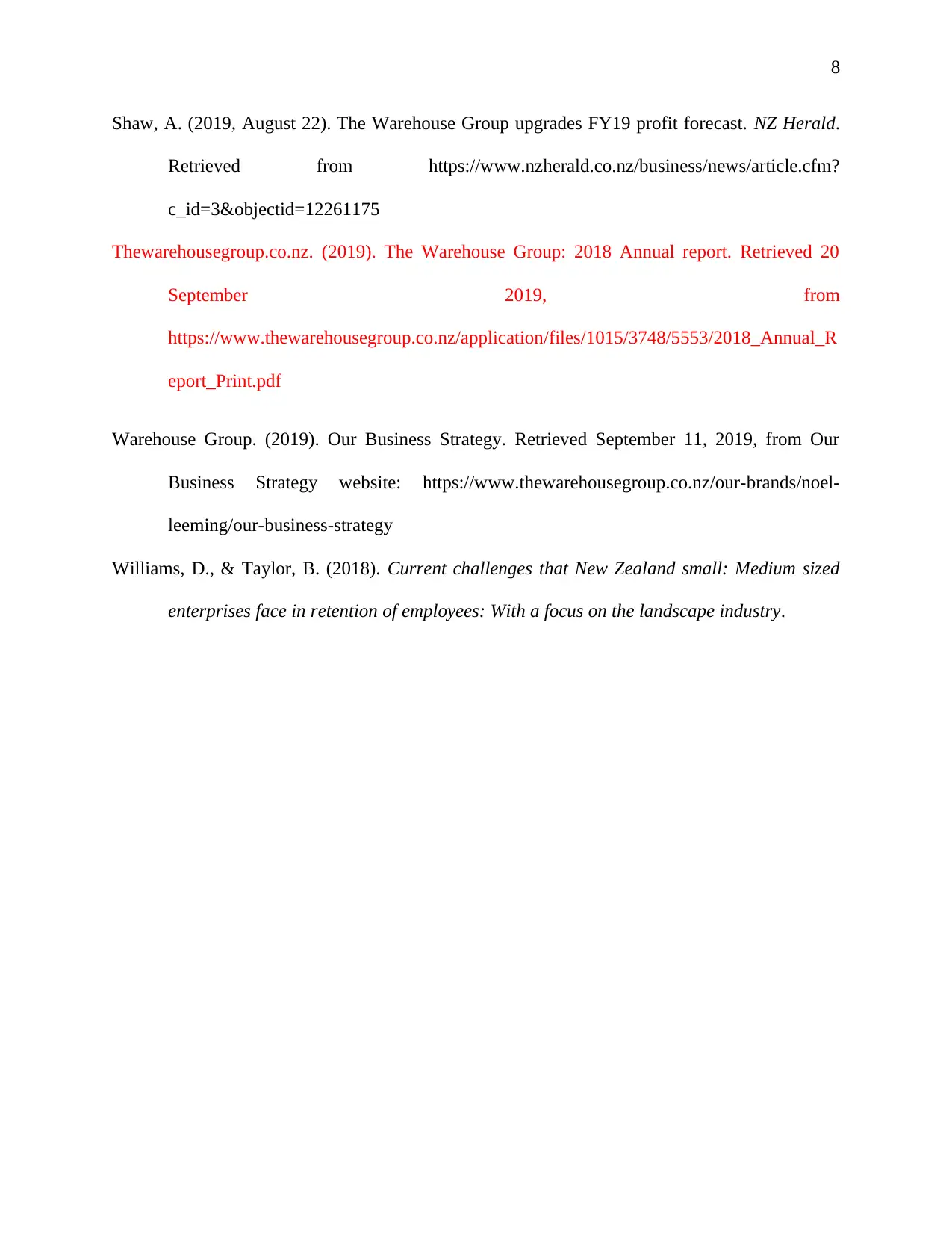
8
Shaw, A. (2019, August 22). The Warehouse Group upgrades FY19 profit forecast. NZ Herald.
Retrieved from https://www.nzherald.co.nz/business/news/article.cfm?
c_id=3&objectid=12261175
Thewarehousegroup.co.nz. (2019). The Warehouse Group: 2018 Annual report. Retrieved 20
September 2019, from
https://www.thewarehousegroup.co.nz/application/files/1015/3748/5553/2018_Annual_R
eport_Print.pdf
Warehouse Group. (2019). Our Business Strategy. Retrieved September 11, 2019, from Our
Business Strategy website: https://www.thewarehousegroup.co.nz/our-brands/noel-
leeming/our-business-strategy
Williams, D., & Taylor, B. (2018). Current challenges that New Zealand small: Medium sized
enterprises face in retention of employees: With a focus on the landscape industry.
Shaw, A. (2019, August 22). The Warehouse Group upgrades FY19 profit forecast. NZ Herald.
Retrieved from https://www.nzherald.co.nz/business/news/article.cfm?
c_id=3&objectid=12261175
Thewarehousegroup.co.nz. (2019). The Warehouse Group: 2018 Annual report. Retrieved 20
September 2019, from
https://www.thewarehousegroup.co.nz/application/files/1015/3748/5553/2018_Annual_R
eport_Print.pdf
Warehouse Group. (2019). Our Business Strategy. Retrieved September 11, 2019, from Our
Business Strategy website: https://www.thewarehousegroup.co.nz/our-brands/noel-
leeming/our-business-strategy
Williams, D., & Taylor, B. (2018). Current challenges that New Zealand small: Medium sized
enterprises face in retention of employees: With a focus on the landscape industry.
1 out of 8
Related Documents
Your All-in-One AI-Powered Toolkit for Academic Success.
+13062052269
info@desklib.com
Available 24*7 on WhatsApp / Email
![[object Object]](/_next/static/media/star-bottom.7253800d.svg)
Unlock your academic potential
Copyright © 2020–2025 A2Z Services. All Rights Reserved. Developed and managed by ZUCOL.





